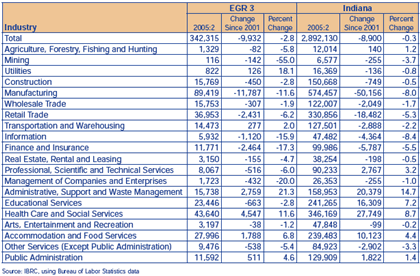Regional Perspective: Economic Growth Region 3
The 11 counties that make up Indiana's Economic Growth Region (EGR) 3 include Adams, Allen, De Kalb, Grant, Huntington, Lagrange, Noble, Steuben, Wabash, Wells and Whitley counties. The region covers nearly 4,375 square miles of land and boasts a 2004 population of 738,795. While that number was only 11.8 percent of Indiana's population and a miniscule 0.3 percent of the U.S. population, it is larger than 66 of the world's countries. Table 1 shows the 5 countries with the closest population to EGR 3.
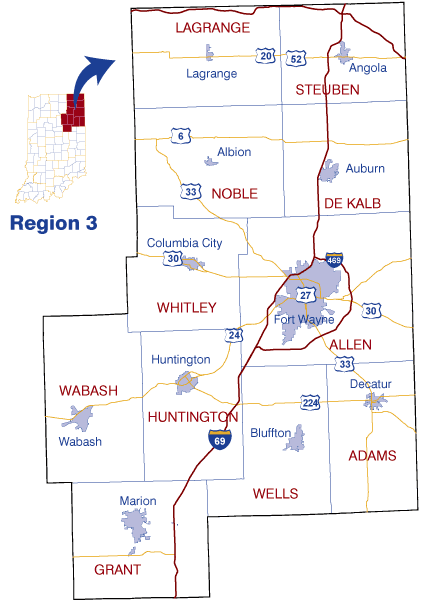
Table 1: Countries with the Nearest Population to Indiana's EGR 3, 2004
At a more local level, Allen County makes up 46.3 percent of the region's population with 342,168 people. Grant County is next in line with 9.7 percent (71,543 people) of the region's population, while all other counties range from 6.4 percent to 3.8 percent (see Figure 1). From 2000 to 2004, Grant and Wabash counties were the only two to lose residents. All other counties gained anywhere from 24 people (Huntington County) to 9,427 (Allen County). Perhaps one of the most interesting population statistics for the region is that 37 percent of the Lagrange County population is Amish, (1) making it the third largest Amish community in the nation, behind Lancaster County, Pa. (second largest), and Holmes County, Ohio (largest). (2)
Figure 1: EGR 3 Population Distribution
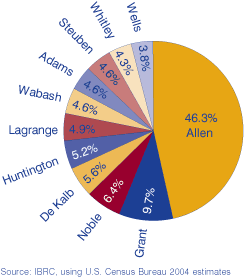
Jobs
In the second quarter of 2005, the manufacturing industry made up 26.1 percent of all jobs in the region, down from its 2001 level of 28.7 percent. EGR 3 experienced a loss of nearly 11,800 manufacturing jobs in those four years. Major increases in the health care and social services, administrative support and waste management, and accommodation and food services industries would have helped offset manufacturing losses if it hadn't been for additional declines in the retail trade, finance and insurance, and information industries (see Table 2). As a result of those dramatic decreases, EGR 3 lost over 1,000 more jobs than Indiana lost.
Table 2: Change in Jobs in EGR 3 and Indiana, 2001:2 to 2005:2
It is important to note that the mining and management of companies and enterprises industries lost 55 percent and 20 percent of jobs, respectively. However, even before these recent losses, they only made up a combined 0.7 percent of all jobs in the industry, meaning that while losses were significant at the individual industry level, they were not as noteworthy in terms of the number of jobs.
Income and Wages
EGR 3 has not fared as well as the state in terms of average weekly wages paid, neither across all industries nor by individual industry sector. Among all major industry classifications, only educational services paid more (by an average of $16 more per week) in Region 3 than at the state level (see Figure 2). Across all industries, Indiana paid $37 more per week.
Figure 2: EGR 3 Average Weekly Wages by Industry, 2005:2
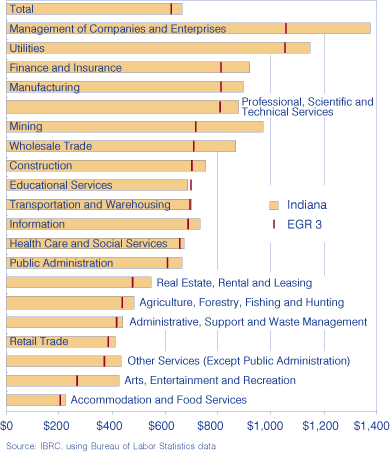
The good news is that Region 3 is improving. The not-so-good news is that EGR 3 hasn't improved as much as the state. From 2001:2 to 2005:2, regional wages increased across every industry except mining and management of companies and enterprises. Meanwhile, these two industries were among the fastest growing in terms of average weekly wages paid at the state level. Region 3 decreased wages paid in the mining industry by $153 per week and wages paid in the management of companies and enterprises industry by $9 per week. At the same time, Indiana's average weekly wages paid in mining and management of companies and enterprises increased by $108 and $197, respectively.
Commuting
Of the 350,582 people that work in the region, 95.8 percent also reside in EGR 3 according to Census data. In other words, only 4.2 percent of the regional workforce lives outside the region. At a more local level, Allen County preceded all the other counties in terms of number of workers who both live and work in the same county, with nearly 150,000 people falling into that category. The next in line was Grant County, with just under 27,000 people who live and work in the same county, a difference between first and second place of about 123,000 people.
Of the eleven counties, only Allen, Huntington and Whitley provided workers for every county in the region. Meanwhile, more people leave their county of residence for work in a fellow EGR county than for work outside the region altogether, except for Grant and Lagrange counties. Grant County has 3,480 people leaving the region entirely and only 1,958 commuting to fellow EGR counties (see Figure 3). Lagrange County shows similar results, with over 3,700 commuters leaving the region and not quite 2,300 commuting within the region.
Figure 3: EGR 3 Commuting Patterns
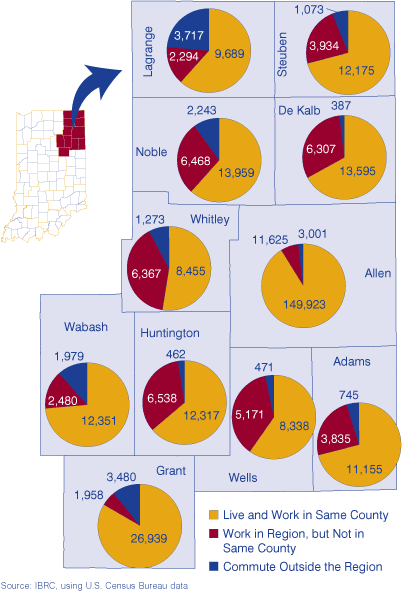
Conclusion
EGR 3 lags the state on numerous economic levels. Population growth in the region was 0.6 percentage points lower than the state; EGR 3 lost 9,932 jobs compared to 8,900 lost in Indiana; and average weekly wages were less in Region 3 than they were in Indiana overall. Only time will tell how EGR 3 and the rest of Indiana will emerge from economic pressures that seem to weigh heavily on transformations in the manufacturing industry.
Notes
- Lagrange County, Indiana, Chamber of Commerce (www.lagrangechamber.org/)
- The two largest Amish communities in the United States are in Lancaster County, Pennsylvania and Holmes County, Ohio. Holmes County, Ohio claims to be the largest (according to the Holmes County Chamber of Commerce at www.visitamishcountry.com/), making Lancaster County, Pa. the second largest.
Molly Marlatt, Research Associate
Indiana Business Research
Center, Kelley School of Business, Indiana University


